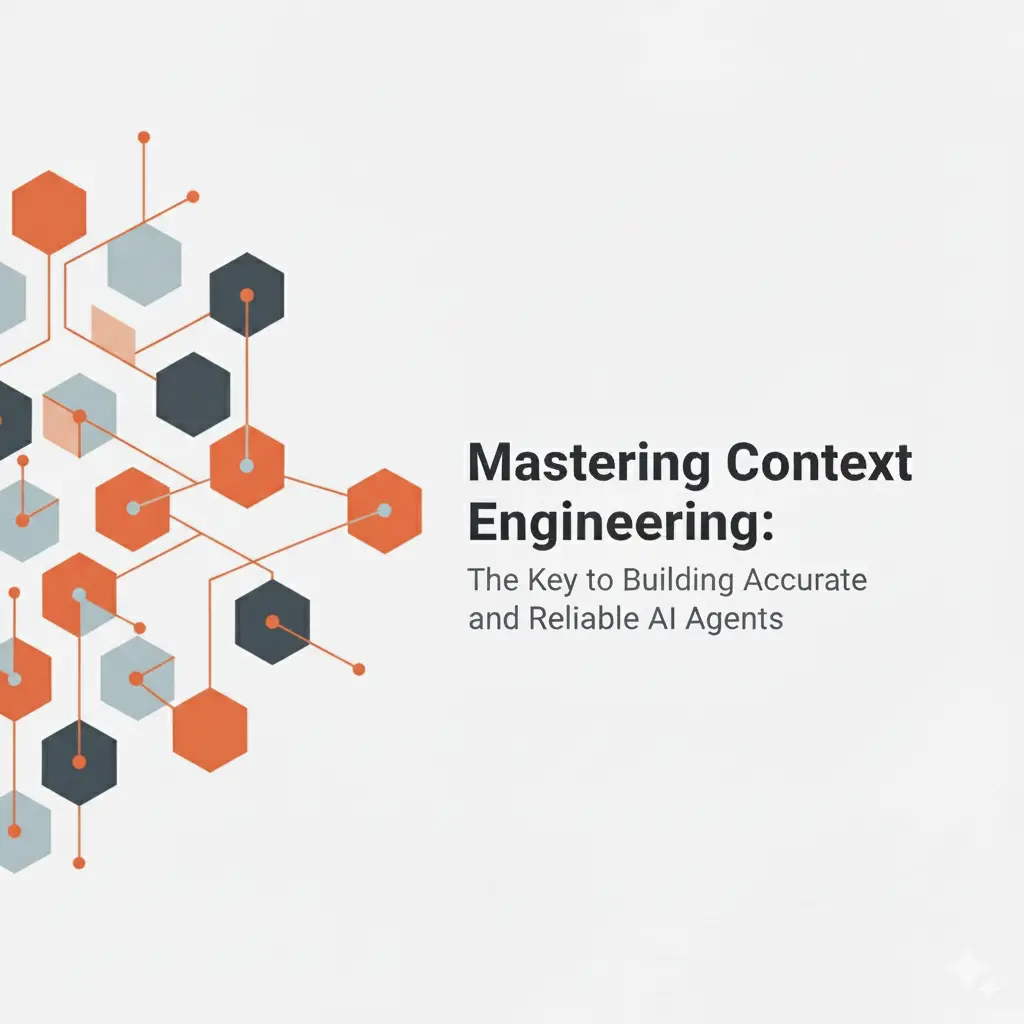
Mastering Context Engineering: The Key to Building Accurate and Reliable AI Agents
As AI agents evolve from simple question-answering systems into autonomous decision-makers, the importance of context engineering has never been greater. In this blog, we'll explore what context engineering is, why it matters, and how it can dramatically improve the accuracy, consistency, and reliability of enterprise-grade AI applications.
Introduction: Why Context Engineering Matters
AI applications are rapidly transforming. What once were basic Q&A bots are now intelligent agents capable of reasoning, planning, and executing actions autonomously—continuing until a task is fully completed. These agents not only provide information but also make decisions, coordinate actions, and interact with external systems.
In this new paradigm, the performance of your AI agent is no longer solely dependent on the choice of LLM (Large Language Model). Instead, it hinges on how effectively you manage and engineer the context provided to the LLM. Context engineering plays a critical role in enhancing accuracy and reducing hallucinations. This blog will delve into:
- The importance of context engineering
- Its core components
- How to structure context for industrial-grade applications
Core Components of Context Engineering
Context engineering is a systematic process that defines, curates, manages, and delivers the right information to an AI agent at the right time. This ensures the agent can complete tasks accurately and consistently.
At its core, context engineering answers key questions:
- How much information does the agent need?
- How should that information be structured for easy consumption?
- How should context evolve as the conversation progresses?
Key Components:
- System Instructions: Define the agent's identity, role, behavior, and limitations.
- Domain Knowledge: Retrieved via RAG (Retrieval-Augmented Generation) from enterprise sources like knowledge graphs, policies, and product data.
- Tool Definitions: Clarify what tools the agent can use and when.
- Memory:
- Short-term: Current session interactions.
- Long-term: Past user preferences and actions.
- Reasoning & Planning: Steps the agent must follow to complete a task.
- User Input: The actual question or task provided by the user.
Understanding the Context Window
The context window of an LLM determines how much information it can process at once. Understanding its limitations is crucial:
- Too little data: The model may not perform well.
- Too much data: Increases cost and cognitive load.
Striking the right balance between relevance and token limits is both a science and an art. The goal is to provide just enough relevant information for the LLM to perform the task effectively.
Role of System Instructions
System instructions are foundational. They define:
- The agent's tone and persona
- Expected behavior and boundaries
- Brand alignment
These instructions are written in natural language and help shape the agent's responses. They are a major part of the context that guides agent behavior.
Defining Tools for Agents
Tool definitions are the second most critical component of context. They inform the agent:
- What capabilities it has
- When and how to use external tools
Clear tool definitions reduce ambiguity and improve task execution accuracy. They also help the agent choose the right tool for the right task.
Short-Term and Long-Term Memory
Short-Term Memory:
Includes all information from the current user session. This allows the agent to maintain context and provide relevant responses without asking the user to repeat themselves.
Long-Term Memory:
Stores past interactions and actions. When included in context, it enables the LLM to personalize responses and reduce redundant queries.
RAG and Knowledge Base Integration
RAG (Retrieval-Augmented Generation) is essential for real-time task completion. It retrieves relevant domain knowledge and integrates it into the context, allowing the LLM to generate more accurate and deterministic responses.
The better the quality and relevance of retrieved data, the higher the response quality and the lower the hallucination rate.
Information Fusion Techniques
Once all context components are ready, structuring them effectively is key. Proper structuring reduces the LLM's cognitive load and improves information retrieval.
Best Practices:
Use tag-based formatting to structure context for optimal LLM comprehension:
<system_instructions>
You are a customer service agent for TechCorp. Be helpful, professional, and concise.
Always verify customer information before making changes. If you cannot help, escalate to human support.
</system_instructions>
<domain_knowledge>
Product Information:
- TechCorp Pro Plan: $29/month, includes 24/7 support
- Standard Plan: $9/month, business hours support only
- Enterprise Plan: Custom pricing, dedicated account manager
Policy Information:
- Refunds available within 30 days of purchase
- Account cancellation requires 48-hour notice
</domain_knowledge>
<tool_definitions>
Available Tools:
1. check_account_status(customer_id) - Retrieve customer account details
2. process_refund(order_id, amount) - Process refund requests
3. update_billing(customer_id, new_plan) - Change subscription plan
4. escalate_to_human() - Transfer to human agent
</tool_definitions>
<short_term_memory>
Current conversation:
- Customer asked about upgrading from Standard to Pro plan
- Customer ID: CUST-12345
- Current plan: Standard ($9/month)
</short_term_memory>
<long_term_memory>
Customer preferences:
- Prefers email communication over phone calls
- Previously upgraded service twice in past year
- High satisfaction scores in past interactions
</long_term_memory>
<reasoning_steps>
1. Verify customer identity and current plan status
2. Explain Pro plan benefits and pricing
3. Check for any ongoing promotions or discounts
4. Process upgrade request if customer agrees
5. Send confirmation email with updated billing details
</reasoning_steps>
<guardrails>
Safety boundaries:
- Never share other customers' information
- Require verification for account changes
- Do not promise features not yet available
- Escalate complex billing disputes to human agents
</guardrails>
<user_input>
I'd like to upgrade my account to the Pro plan. Can you help me with that?
</user_input>
Key Benefits:
- Tagging improves the LLM's ability to parse and act on information accurately
- Each tagged section contains complete, self-contained information
- Components are ordered by importance: system instructions first, user input last
- Clear separation makes debugging and optimization easier
Using Examples in Context
Providing examples within context helps the agent understand expected behavior. A well-structured context may include:
- Tagged system instructions
- Short and long-term memory
- Tool definitions
- Guardrails
- Reasoning steps
These examples guide the agent's behavior and improve consistency in responses.
Reducing Hallucinations and Improving Consistency
LLMs are inherently non-deterministic—they don't "know" what's true. Without verified enterprise data, they may hallucinate.
Key Considerations:
- Use verified databases to avoid hallucinations.
- Maintain consistent agent behavior by structuring context for similar user queries.
- Avoid overloading the LLM with unnecessary data to reduce cognitive load.
Context engineering ensures only relevant data is included, improving accuracy, relevance, and trust.
Context Quality and Agent Accuracy
In summary, the better your context, the better your agent performs.
- Higher accuracy
- Reduced hallucinations
- Improved user trust and safety
- Balanced cost vs. performance
Context engineering is not optional—it's essential for building production-grade AI agents that deliver consistent, reliable, and intelligent results.
By mastering context engineering, you unlock the full potential of AI agents, ensuring they are not just smart—but also safe, scalable, and enterprise-ready.
Ready to build enterprise-grade AI agents with proper context engineering?
Start building smarter agents with AvestaLabs:
- Expert consultation on context engineering best practices
- Complete RAG implementation with IngestIQ
- Agent monitoring and optimization with MetricSense
- Full-stack AI agent development services
Get started today: hello@avestalabs.ai

Seasoned software engineer and AI strategist with over 13 years of experience. I specialize in building high-performance, secure cloud-native systems and crafting AI solutions that deliver real business value.


